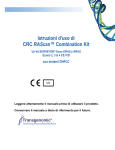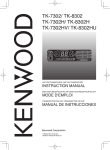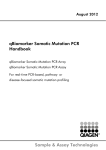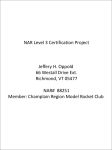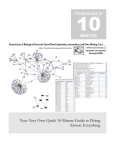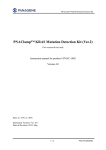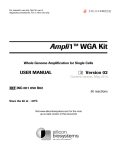Download ICEme Kit User Manual
Transcript
User Guide for the ICEme Kit Multiplex ICE COLD-PCR Mutation Enrichment Kit Transgenomic® Advancing Personalized Medicine This product is for Research Use Only Table of Contents Reagent Preparation . . . . . . . . . . . . . . . . . . . . . . . . . . . . . . . . . . . . . . . . . . . . . . . . . . . . . . . . 2 Storage . . . . . . . . . . . . . . . . . . . . . . . . . . . . . . . . . . . . . . . . . . . . . . . . . . . . . . . . . . . . . . . . . . . 2 Principles of the ICEme Kit for Mutation Detection . . . . . . . . . . . . . . . . . . . . . . . . . . . . . . 2 Analysis of Samples using ICEme Kit . . . . . . . . . . . . . . . . . . . . . . . . . . . . . . . . . . . . . . . . . . . . . . . . . . . 2 Kit Components . . . . . . . . . . . . . . . . . . . . . . . . . . . . . . . . . . . . . . . . . . . . . . . . . . . . . . . . . . . 3 MX PCR and MX-ICP Kit Components . . . . . . . . . . . . . . . . . . . . . . . . . . . . . . . . . . . . . . . . . . . . . . . . . . 4 Number of Samples that can be tested with one ICEme Kit��������������������������������������������������������������� 4 Additional Required Equipment and Reagents . . . . . . . . . . . . . . . . . . . . . . . . . . . . . . . . 4 Primary Sample Collection, Handling and Storage . . . . . . . . . . . . . . . . . . . . . . . . . . . . . 4 MX PCR Step-by-Step Instructions . . . . . . . . . . . . . . . . . . . . . . . . . . . . . . . . . . . . . . . . . . . 4 MX PCR Pre-Amplification Protocol . . . . . . . . . . . . . . . . . . . . . . . . . . . . . . . . . . . . . . . . . . . . . . . . . . . . 5 Thermal Cycler Program for the MX PCR Amplification Protocol����������������������������������������������������� 6 Quality Control of MX PCR Products (optional) . . . . . . . . . . . . . . . . . . . . . . . . . . . . . . . . . . . . . . . . . . 6 MX PCR Product Analysis . . . . . . . . . . . . . . . . . . . . . . . . . . . . . . . . . . . . . . . . . . . . . . . . . . . . . . . . . . . . 7 Use of Positive Control . . . . . . . . . . . . . . . . . . . . . . . . . . . . . . . . . . . . . . . . . . . . . . . . . . . . . . . . . . . . . . . 7 Limitations of the MX PCR Assay Procedure . . . . . . . . . . . . . . . . . . . . . . . . . . . . . . . . . . . . . . . . . . . . . 7 MX-ICP Step-by-Step Instructions . . . . . . . . . . . . . . . . . . . . . . . . . . . . . . . . . . . . . . . . . . . . 7 Thermal Cycler Program for MX-ICP Enrichment . . . . . . . . . . . . . . . . . . . . . . . . . . . . . . . . . . . . . . . . . 9 Quality Control of MX-ICP Products (optional) . . . . . . . . . . . . . . . . . . . . . . . . . . . . . . . . . . . . . . . . . 10 MX-ICP Product Analysis . . . . . . . . . . . . . . . . . . . . . . . . . . . . . . . . . . . . . . . . . . . . . . . . . . . . . . . . . . . . 10 Use of Positive Control . . . . . . . . . . . . . . . . . . . . . . . . . . . . . . . . . . . . . . . . . . . . . . . . . . . . . . . . . . . . . . 10 Limitations of the MX-ICP Assay Procedure . . . . . . . . . . . . . . . . . . . . . . . . . . . . . . . . . . . . . . . . . . . . 10 Warnings & Precautions . . . . . . . . . . . . . . . . . . . . . . . . . . . . . . . . . . . . . . . . . . . . . . . . . . . . 10 Resources . . . . . . . . . . . . . . . . . . . . . . . . . . . . . . . . . . . . . . . . . . . . . . . . . . . . . . . . . . . . . . . . 11 Quality Statement . . . . . . . . . . . . . . . . . . . . . . . . . . . . . . . . . . . . . . . . . . . . . . . . . . . . . . . . . 11 Licenses, Trademarks & Copyright . . . . . . . . . . . . . . . . . . . . . . . . . . . . . . . . . . . . . . . . . . . 11 User Guide 1 ICEme Kit PLEASE READ THIS USER GUIDE THOROUGHLY BEFORE YOU START USING THIS PRODUCT. THIS USER GUIDE CAN BE DOWNLOADED FROM THE TRANSGENOMIC WEBSITE. Transgenomic’s ICEme Kit is an in vitro assay that uses multiplexed PCR (MX PCR) followed by multiplexed ICE COLDPCR (MX-ICP) for amplification and enrichment of mutations in KRAS Exons 2, 3 and 4, NRAS Exons 2, 3 and 4, BRAF Exons 11 and 15, PIK3CA Exons 9 and 20, EGFR Exons 12, 18, 19, 20 and 21. Subsequent sequence analysis of MX-ICP products is performed on any downstream sequence analysis platform currently in use. MX PCR products produced using this kit range from 130 - 220 bp; MX-ICP products vary in length, but they are all less than 200 bp. MX-ICP products can be used as templates for the user-selected particular downstream sequence detection platform. Note: This is a Research Use Only kit. Sale of this product is conditioned on the Limited Use License which you accept by purchasing this product and is available for download from within the Documentation Tab on ICEme Kits Details and Ordering Page on the Transgenomic website. Reagent Preparation All reagents supplied with this ICEme Kit are ready to use. Some components will need to be thawed, vortexed and/ or spun in a microcentrifuge before use; check details in Assay Procedure below. Reagents do need to be combined to produce Master Mixes and reaction mixtures; full details are given in the Assay Procedure below. Storage The kit should be stored between -18 °C and -25°C in a constant temperature freezer until use. Principles of the ICEme Kit for Mutation Detection This kit uses Transgenomic’s proprietary primer sets for MX PCR amplification and MX-ICP mutation enrichment. A general overview of the process is shown in Overview of Multiplexed ICE-COLD PCR (MX-ICP) located within the Documentation Tab on ICEme Kits Details and Ordering Page on the Transgenomic website. It is recommended that laboratory set-up is optimized to avoid sample or control cross-contamination. For an example of an ideal laboratory set-up, see Laboratory Setup to perform Multiplexed ICE-COLD PCR (MX-ICP) located within the Documentation Tab on ICEme Kits Details and Ordering Page on the Transgenomic website. Analysis of Samples using ICEme Kit The ICEme Kit should only be used in the context of the workflow indicated in Figure 1. All components necessary for downstream sequencing platforms must be supplied by the laboratory using this kit. Figure 1. ICEme Kit workflow for Mutation Analysis any Downstream Sequencing Platform MX PCR MX-ICP Patient Sample User Guide Downstream Sequence Detection Platform 2 ICEme Kit Note: 1. Due to heterogeneity associated with tumors, biopsy samples may contain normal cells as well as Wild-Type and mutant tumor cells. 2. The Limit of Detection (LOD) of any mutations present in the sample DNA following MX PCR is dependent on the sensitivity of the downstream sequence detection platform used. 3. Only the DNA Polymerases supplied with this kit should be used as indicated for the MX PCR and MX-ICP assays. 4. Please follow the specific instructions for your laboratory’s downstream sequence detection platform by consulting the appropriate instruction manual. First time users should perform control experiments outlined in the document Positive Control for ICEme Kit located within the Documentation Tab on ICEme Kits Details and Ordering Page on the Transgenomic website. Kit Components The ICEme Kit contains the components needed to perform MX PCR pre-amplification and MX-ICP mutation enrichment. Table 1. MX PCR Kit Components MX PCR Kit Components Tube Cap Color No. Tubes in Kit Volume 8 reactions 24 Reactions Phusion® HS II DNA Polymerase Orange 1 4 µL 12 µL 5X GC Buffer for Phusion® HS II White 1 1.5 mL 1.5 mL dNTPs (10mM)* Clear 1 55 µL 125 µL MX PCR Primer Mix Blue 1 20 µL 60 µL MX-ICP Positive Control Black 1 15 µL 15 µL * dNTPs 10mM (2.5 mM each of dATP, dCTP, dGTP and TTP) Table 2. MX-ICP Kit Components MX PCR Kit Components Tube Cap Color No. Tubes in Kit Volume 8 reactions 24 Reactions Phusion® HS II DNA Polymerase Orange 1 4 µL 12 µL JumpStart™ Taq DNA Polymerase Red 1 12 µL 12 µL 5X GC Buffer for Phusion® HS II White 1 1.5 mL 1.5 mL 10X JumpStart Reaction Buffer White 1 150 µL 150 µL dNTPs (10mM)* Clear 1 55 µL 125 µL MX-ICP Primer Green 1 8 µL 24 µL RS-oligo Yellow 1 20 µL 60 µL * dNTPs 10mM (2.5 mM each of dATP, dCTP, dGTP and TTP) User Guide 3 ICEme Kit MX PCR and MX-ICP Kit Components There is an ICEme Kit available for each exon. The polymerase supplied with a specific exon kit is indicated in the section entitled Thermal Cycler Program for MX-ICP Enrichment Protocol. Number of Samples that can be tested with one ICEme Kit The total number of samples that can be tested with the kit’s components depends upon the average batch size tested at any one time because at least one No Template Control (NTC) must be run for each batch. Additional Required Equipment and Reagents For additional components and equipment required to use the ICEme Kit see the document Reagents and Equipment required for ICEme Kit located within the Documentation Tab on ICEme Kits Details and Ordering Page on the Transgenomic website. Primary Sample Collection, Handling and Storage The ICEme Kit can be used with the following: • DNA extracted from formalin-fixed paraffin-embedded tumor samples (FFPE slides & blocks) or fine needle aspirations (FNAs) • Circulating free DNA (cfDNA) from plasma or serum • DNA isolated from other body fluids For optimal DNA extraction from FFPE, the tissue should be fixed in neutral buffered formalin for 14–24 hours, placed in ethanol and then embedded in paraffin following standard histological practices. Tumor biopsies are a heterogeneous mixture of tumor cells and non-tumor cells. In addition the tumor itself is a heterogeneous mixture of tumor cells with mutations and tumor cells without mutations. Because these somatic mutations may not be evenly distributed throughout the tumor, the resultant mutational analysis of different sections from the same tumor may be different. To increase the probability of detecting a mutation, DNA from the tumor region of the tissue should be isolated by scraping only the tumor area from the glass slide using a fresh, sterile scalpel for each new slide. It is recommended that at least two independent analyses are performed for each sample. For successful use of this kit, the extracted DNA should meet the criteria listed in the document Template Considerations for Extracted DNA located within the Documentation Tab on ICEme Kits Details and Ordering Page on the Transgenomic website. Note: 1. Extracted DNA samples not intended for immediate analysis with this kit should be stored frozen at -20ºC to -80ºC. 2. The PCR product from the MX PCR pre-amplification reaction can be stored frozen at -20ºC to -80ºC prior to use in MX-ICP assays. 3. The PCR product following the MX-ICP enrichment assay can be stored frozen at -20ºC to -80ºC prior to use in the downstream sequence detection platform used by the laboratory. 4. Exposure of any frozen sample to repeated freeze-thaw cycles should be avoided. MX PCR Step-by-Step Instructions Please refer to the document Template Considerations for Extracted DNA located within the Documentation Tab on ICEme Kits Details and Ordering Page on the Transgenomic website before using this protocol. User Guide 4 ICEme Kit MX PCR Pre-Amplification Protocol 1. Remove MX PCR Primer Mix, dNTPs and 5X GC Buffer from freezer and thaw on ice. 2. Once thawed, vortex all kit components ~10 seconds to mix thoroughly. Briefly centrifuge ~10 seconds to ensure no liquid remains on tube lids and place on ice. 3. Prepare MX PCR Master Mix on ice. Table 3. MX PCR Master Mix Guidance for 10 ng/µL DNA samples MX PCR Master Mix* 1X Volume Calculation*: UV-treated Molecular Biology Grade Water (µL) 18 5X GC Buffer (µL) 10 dNTPs (µL) 4 MX PCR Primer Mix (µL) 2.5 Phusion HS II DNA Polymerase (µL) 0.5 Total Volume MX PCR Master Mix for 1 reaction (µL) 35.0 Volume DNA added to reaction (150 ng total) 15.0 *Multiply volumes in this table by the number of samples being tested. 4. Use Table 3 as a guide for preparing the MX PCR Master Mix for MX PCR reactions. Amount of UV-treated Molecular Biology Grade Water and volume of DNA can be adjusted accordingly. 150 ng of DNA should be used for each MX PCR reaction in order to potentially detect ≥ 0.01% mutation present in the starting material. Up to 33 µL DNA can be used in each MX PCR reaction with adjustment of volume of water used. Note: If DNA contains contaminants (ethanol carryover, EDTA etc.), increasing DNA volume may decrease MX PCR efficiency. 5. Calculate required volumes for any given MX PCR Master Mix referencing Table 3. 6. If required, a Positive Control Mixture may be used in place of a sample (there is enough positive control for 3 reactions). Note: Take into consideration that an MX PCR Master Mix volume slightly greater than the calculation above will be required to allow for losses during pipetting. 7. Label 0.2 mL-PCR tubes or wells of a 96-well plate with appropriate sample information. 8. Label a 1.7 mL-centrifuge tube for MX PCR Master Mix preparation. 9. Add required volume of UV-treated molecular biology grade water to 1.7 mL-centrifuge tube labeled “MX PCR Master Mix”. 10. Add required amount of 5X GC Buffer, dNTPs and MX PCR Primer Mix to MX PCR Master Mix tubes. 11. Take the DNA Polymerase out of the freezer, vortex for ~10 seconds, centrifuge for ~10 seconds and add required volume of DNA Polymerase to the MX PCR Master Mix tube. Cap MX PCR Master Mix tube. 12. Before use, vortex MX PCR Master Mix tube for ~30 seconds and centrifuge for ~10 seconds. Store on ice until use. 13. Pipette 35.0 µL MX PCR Master Mix into appropriate wells, changing pipette tips in between uses if using a single channel pipettor. If using a repeat pipettor, ensure that there is no spillage or splashing from well to well. Keep the plate on ice. User Guide 5 ICEme Kit 14. To appropriate wells, add 15.0 µL of each sample template DNA or water (No Template Control, NTC). Use separate pipette tips for each sample and avoid cross-contamination of the samples by splashing. Cap wells containing sample DNAs and NTC with 8-cap strips (if using a 96-well plate) or cap 0.2 mL-PCR tubes. Make sure caps are sealed securely. Note: Good practice is to place No Template Controls (NTC) in wells that are not adjacent to wells containing Positive Controls or Test Samples. 15. Optional sample: only after Step 14 is complete, open MX-ICP Positive Control. Pipette an additional 10 µL of Molecular Biology Grade H2O and 5 µL of MX-ICP Positive Control into Positive Control well/tube and cap well/ tube. Addition of the kit positive control as the last sample to be added, lessens the chance of contaminating any test sample DNA. Cap each well with 8-cap strips (if using a 96-well plate) or cap 0.2 mL-PCR tubes. Make sure caps are sealed securely. 16. Vortex (~1/2 speed) for 10 seconds. Centrifuge for ~20 seconds to ensure all solutions are collected at the bottom of wells or tubes. Verify that solutions are at the bottom of each well or tube. If not, repeat centrifugation. Thermal Cycler Program for the MX PCR Amplification Protocol 1. Use the thermal cycler protocol in Table 4 for MX PCR Amplification. Ramp Rates: C1000: 1.5 °C/sec; Veriti: 38.5%; Tetrad: default (3.0 °C/sec) Table 4. MX PCR Amplification Thermal Cycler Protocol Initial Denaturation Touchdown Amplification Amplification Final Extension Cycles Temp (°C) Time 1 98 °C 30 sec 15 98 °C 10 sec 15 62 °C, -0.5 ºC/cycle 20 sec 15 72 °C 20 sec 20 98 °C 10 sec 20 55 °C 20 sec 20 72 °C 20 sec 1 72 °C 5 min 12 ºC Hold Hold Note: Store samples at -20 °C. Quality Control of MX PCR Products (optional) 1. Analyze MX PCR product aliquots with an aliquot of a standard 100-bp DNA mass ladder on a 2% agarose gel. 2. Use the ladder to estimate MX PCR amplified DNA concentration. 3. Bands ranging from 130 - 220 bp corresponding to the main MX PCR product should be observed. 4. If no product is observed, ensure quality of input template DNA was sufficient. 5. No MX PCR products should be visible in the NTC sample. A. If DNA products are visible with NTC, contamination is likely and the sample should not be taken forward. 6. Use your laboratory’s procedures for NGS analysis of the test samples. TIP: AT THIS STAGE MX PCR PRODUCTS CAN BE STORED AT LESS THAN OR EQUAL TO -20 ºC PRIOR TO ENRICHMENT WITH MX - ICP. User Guide 6 ICEme Kit MX PCR Product Analysis The PCR product generated by MX PCR pre-amplification reactions can be used in any of the kit’s MX-ICP assay(s). Use of Positive Control See the document Positive Control for ICEme Kit located within the Documentation Tab on ICEme Kits Details and Ordering Page on the Transgenomic website. Limitations of the MX PCR Assay Procedure See the document Limitations of ICEme Kit located within the Documentation Tab on ICEme Kits Details and Ordering Page on the Transgenomic website. MX-ICP Step-by-Step Instructions Please refer to Template Considerations before using this protocol 1. Procedure-Setup Ensure that the following ramp rates are used depending on thermal cycler: A. C1000: 1.5°C/sec B. Veriti: 38.5% C. Tetrad: default (3.0°C/sec) 2. Preparation of Template DNA for ICE COLD-PCR Analysis Template DNA will contain amplified product from 15 amplicons A. Qubit analysis should be performed on the MX PCR product. I. For those samples and controls with Qubit values >7 ng/µL, dilute the MX PCR product 1:200 in water (except KRAS 4B which would be 1:10 in water). II. Dilute the No Template Control from the MX PCR plate (NTC1) 1:200 in water. III. For those samples with Qubit values <7 ng/µL, DO NOT PROCEED with MX-ICP Analysis a. The MX PCR should be repeated with more starting DNA b. An additional sample may be needed B. If previously prepared and stored frozen, allow to thaw prior to use. 3. MX-ICP after MX PCR A. The following procedures should be performed in PCR Workstations. I. Use appropriate pipettes to aliquot reagents. II. Prior to PCR setup: a. Turn on UV crosslinker and allow to warm up/equilibrate for 5 min. b. Prior to preparing Master Mixes, UV crosslink all empty Master Mix tubes. Also UV crosslink 1.7 mL tubes containing appropriate volume of Molecular Biology Grade Water needed for Master Mix preparation. These tubes should be UV irradiated for 10 min (600 sec). c. Make sure all work areas are prepared for analysis of low level mutations. This includes correct use of the PCR Workstation, dedicated pipettes, tips, 10% bleach solution and DNA Away™ solutions. B. Remove MX-ICP Primers, dNTPs, RS-oligo and Polymerase Buffer tubes from freezer, thaw on ice, vortex each for 10 sec and briefly centrifuge tubes to ensure no sample is on tube cap or sides of the tubes. C. Prepare Master Mix on ice. User Guide 7 ICEme Kit D. Use Table 5 as a guide for preparing the Master Mix for each MX-ICP reaction assuming 1.0 µL of 1:200 (or 1:10 for KRAS 4B) dilution of MX PCR product is to be used/reaction. Table 5. Master Mix Preparation Volumes per Reaction JumpStart Polymerase Phusion Polymerase Volume of Water 36.0 µL 31.375 µL Polymerase Buffer 5.0 µL 10.0 µL dNTPs 4.0 µL 4.0 µL MX-ICP Primers 1.0 µL 1.0 µL RS-oligo 2.5 µL 2.5 µL DNA Polymerase 0.5 µL 0.125 µL 49.0 µL 49.0 µL Number of Reactions Total Volume Master Mix KRAS Exon 2 & BRAF Exon 15 ONLY E. Calculate required volumes for any given Master Mix by reference to the chart above. Note: an additional reaction will be required for a No Template Control (NTC2). Note: take into consideration that a Master Mix volume slightly greater than this calculation will be required to allow for losses during pipetting. F. Label 0.2 mL-PCR tubes or wells of a 96-well plate with appropriate sample information. G. Label a 1.7 mL-centrifuge tube for Master Mix preparation. H. Add required volumes of molecular biology grade water, Polymerase Buffer, dNTPs, MX-ICP Primers and RSoligo to Master Mix tube. I. Take the DNA Polymerase tube out of the freezer, vortex for ~10 sec, briefly centrifuge and add required volume to Master Mix tube. J. Cap Master Mix tube, vortex for ~10 sec, briefly centrifuge and store on ice until use. K. Pipette 49.0 µL of Master Mix into appropriate wells, changing pipette tips in between if using a single channel pipette. If using a repeat pipettor, ensure that there is no spillage/splashing from well to well. Keep plate/tubes on ice. L. Vortex and spin down diluted MX PCR product and No Template Control. M. To appropriate well, add 1.0 µL water to MX-ICP no template control, NTC2. N. To appropriate well, add 1.0 µL diluted No Template Control from MX PCR (NTC1). Note: Cap no template controls before adding samples from MX PCR products; this includes samples, reference controls and cell line positive control. O. To appropriate well, add 1.0 μL diluted sample from MX PCR. P. To appropriate well, add 1.0 µL diluted mutation positive control from MX PCR, if applicable. Q. Once pipetting is complete, cap each column with cap strips (if using a 96-well plate) or cap 0.2 mL-PCR tubes. Make sure caps are sealed securely. R. Vortex (~1/2 speed) for 10 seconds. Centrifuge for ~20 seconds t o ensure all solutions are collected at the bottom of wells or tubes. Verify that solutions are at the bottom of each well or tube. If not, repeat centrifugation. User Guide 8 ICEme Kit Thermal Cycler Program for MX-ICP Enrichment Use the thermal cycler protocols in Tables 6a and 6b for MX-ICP Enrichment. For specific ramp rates for thermal cycler see Step 1. Procedure Setup under the section MX-ICP Step-by-Step Instructions. Table 6a. Thermal Cycler Protocols for MX-ICP Temperature MX-ICP Reaction KRAS 2 KRAS 3 KRAS 4A KRAS 4B Initial Denaturing 30 cycles Amplification 5 cycles Amplification NRAS 2 NRAS 3 NRAS 4A NRAS 4B BRAF EX 11 BRAF EX 15 Time 95 °C 5 min 95 °C 15 sec 67 °C 2 min 75.5 °C 76.4 ºC 70.5 ºC 70.3 ºC 75.5 ºC 69.0 ºC 69.5 ºC 70.8 ºC 69.7 ºC 69.5 ºC 30 sec 62 °C 52 ºC 55 ºC 55 ºC 62 ºC 60 ºC 61 ºC 55º C 55 ºC 58 ºC 30 sec 62 °C 52 ºC 55 ºC 55 ºC Final Extension 72 °C 30 sec 95 °C 15 sec 62 ºC 60 ºC 61 ºC 55 ºC 55 ºC 58 ºC 30 sec 72 °C 30 sec 72 °C 5 min Table 6b. Thermal Cycler Protocols for MX-ICP Temperature MX-ICP Reaction EGFR Ex 12 EGFR Ex 18 EGFR Ex 19 Initial Denaturing 30 cycles Amplification 5 cycles Amplification Final Extension User Guide EGFR Ex 20 EGFR Ex 21 PIK3CA Ex 9 PIK3CA Ex 20 Time 95 °C 5 min 95 °C 15 sec 67 °C 2 min 70.3 ºC 76.9 ºC 70 ºC 71.0 ºC 78.2 ºC 71.5 ºC 69.7 ºC 30 sec 55 ºC 55 ºC 55 ºC 60 ºC 55 ºC 56 ºC 61 ºC 30 sec 55 ºC 55 ºC 55 ºC 72 °C 30 sec 95 °C 15 sec 60 ºC 55ºC 56 ºC 61 ºC 30 sec 72 °C 30 sec 72 °C 5 min 9 ICEme Kit Note: Store the samples at -20 ºC until sequence analysis. Quality Control of MX-ICP Products (optional) 1. Analyze an aliquot of MX-ICP product with an aliquot of 100-bp DNA mass ladder on a 2% agarose gel to estimate to estimate amplified DNA concentration. 2. Only a single band corresponding to the main MX-ICP product should be observed. 3. If multiple bands are present check quality of input DNA. 4. If no product is observed, ensure quality of input template DNA was sufficient. 5. No MX-ICP products should be visible in No Template Control sample. If DNA products are visible with this control, contamination is likely and sample should not be taken to sequence analysis. 6. Using your laboratory’s procedures proceed to sequence analysis of the test samples. MX-ICP Product Analysis The PCR product generated by the MX-ICP enrichment reactions can now be used for DNA sequence analysis using standard laboratory procedures for the particular platform chosen. If your downstream platform of choice is SANGER, then please use the sequencing primer (one direction only) in Table 7 for your analysis. Table 7. M13 Sanger Sequencing Primer M13seq R AGGAAACAGCTATGACCAT If your downstream platform of choice is NGS, then please see the amplicon targeted regions for MX PCR and MX-ICP. Use of Positive Control See the document Positive Control for ICEme Kit located within the Documentation Tab on ICEme Kits Details and Ordering Page on the Transgenomic website. Limitations of the MX-ICP Assay Procedure See the document Limitations of ICEme Kit located within the Documentation Tab on ICEme Kits Details and Ordering Page on the Transgenomic website. Warnings & Precautions None of the reagents in this kit present a health hazard in the quantities supplied. Transgenomic’s document number SDS-71600X can be found in the document ICEme Kit SDS located within the Documentation Tab on ICEme Kits Details and Ordering Page on the Transgenomic website. There are no substances in this kit of animal or human origin that present a risk of infection. This kit should be used only by those persons who have been trained in the appropriate laboratory techniques. When working with the components of this kit, always wear a suitable lab coat, disposable gloves and eye protection. After use, the kit components should be disposed of as clinical waste and in accordance with your local rules and regulations. Aliquots of reagents pipetted from tubes in this kit are intended for the setup of Master Mixes and should not be stored for the setup of subsequent analyses. User Guide 10 ICEme Kit Resources For additional product information such as troubleshooting guides, SDS documentation, frequently asked questions, Limited Use License or ordering details, please visit the Transgenomic website (transgenomic.com/iceme). Quality Statement ICEme Kit demonstrates enrichment of mutant DNA sequences in excess of Wild-Type DNA through selective amplification of mutant DNA using kit control template and reagents. Licenses, Trademarks & Copyright DNA Polymerase: Use of this product is covered by one or more of the following US patents and corresponding patent claims outside the US:, 5,789,224, 5,618,711, 6,127,155 and claims outside the US corresponding to US Patent No. 4,889,818. The purchase of this product includes a limited, non-transferable immunity from suit under the foregoing patent claims for using only this amount of product for the purchaser’s own internal research. No right under any other patent claim (such as the patented 5’ Nuclease Process claims in US Patents Nos. 5,210,015 and 5,487,972), no right to perform any patented method, and no right to perform commercial services of any kind, including without limitation reporting the results of purchaser’s activities for a fee or other commercial consideration, is conveyed expressly, by implication, or by estoppel. This product is for research use only. Diagnostic uses under Roche patents require a separate license from Roche. Further information on purchasing licenses may be obtained by contacting the Director of Licensing, Applied Biosystems, 850 Lincoln Centre Drive, Foster City, California 94404, USA. Transgenomic® Advancing Personalized Medicine For more information visit transgenomic.com/iceme Transgenomic, Inc. | 12325 Emmet Street | Omaha, NE 68164 | USA | 888-813-7253 | [email protected] | transgenomic.com Transgenomic is a registered trademark; ICEme, the helix and MX-ICP logos are trademarks of Transgenomic, Inc. All other trademarks are trademarks of their respective holders. ©2015 Transgenomic, Inc. | All rights reserved | Document No. 602435-00 | 06.28.15 User Guide 11 ICEme Kit












